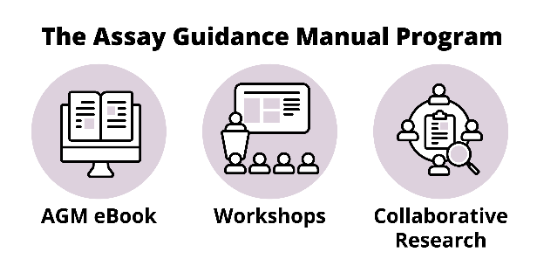Assay Guidance Manual Program
A unique translational science initiative, the Assay Guidance Manual Program, aims to create and disseminate best laboratory practices, tools for data analysis, and standards for rigor in preclinical drug discovery.
About the Assay Guidance Manual Program
Rapid advances in basic research have led to innovative therapeutic approaches to address unmet medical needs. Yet, a large gap exists between basic research and the translation of those fundamental insights into therapeutics. Our AGM program is a translational science initiative that aims to help bridge this gap.
The AGM program is a world-class source of guidelines and best practices for advancing translational science and research in the preclinical development of novel therapeutics and offers training and insight for those desiring to become translational scientists. This program provides scientists with community-developed best laboratory practices in early translational research, including robust assay development, analytical technologies, data analysis tools and preclinical drug discovery standards. The program also aims to help the preclinical drug discovery workforce understand the value of robust, reproducible and replicable results.
The AGM program provides multiple resources, including the AGM eBook. This manual contains best practices in preclinical drug discovery and is free and publicly available from the National Library of Medicine; its editorial board has members from both the private and public sectors.
The program offers in-person and virtual multiday training workshops and conferences. It also hosts an AGM Preclinical Translational Science Webinar Series. This series highlights distinguished translational scientists who share case studies and information about preclinical translational science.
In addition, the AGM program participates in collaborative research initiatives focused on bottlenecks in translational sciences, such as reproducibility, assay artifacts and interferences, and establishing best practices for preclinical translation.
Learn more about this program in these publications:
The AGM eBook
The Assay Guidance Manual (AGM) is a free, best-practices online resource devoted to the successful development of robust, early-stage drug discovery assays.
AGM Workshops, Symposia, and Webinars
The AGM program offers workshops, symposia, courses and webinars on best practices in early drug discovery as well as on timely drug discovery and public health challenges.
AGM News
- Watch our latest webinar New Therapeutic Modalities Inspired by Glycoscience presented by Carolyn Bertozzi, Ph.D.
- The next webinar in the 2025 season of the AGM Preclinical Translational Science Webinar Series will be Any Target Every Time: How Proximity-Based Drugs Are Redefining Pharmacotherapy by Raymond J. Deshaies, Wednesday, Aug. 27, 2025, from 1–2 p.m. EDT
- New chapter published in the Assay Guidance Manual: Interference and Artifacts in High-Content Screening by Jayme Dahlin, M.D., Ph.D., David A. Close, Paul A. Johnston, Steven Haney, Steve Titus, Bridget Wagner and Joe Trask.
- The chapter provides best-practice recommendations for identifying and mitigating interference through the application of experimental design strategies, statistics, orthogonal, and counter-screens, and the use of reference compounds. Adoption of these recommendations should enhance the quality of chemical matter identified by high-content screening assays.
AGM Publications
Browse a listing of AGM-related, peer-reviewed scientific publications that feature research supported by NCATS programs and initiatives.
October 03, 2023 — The Journal of Infectious Diseases
December 21, 2022 — Nature Reviews Drug Discovery
December 26, 2021 — SLAS Discovery
December 26, 2021 — SLAS Technology
November 01, 2019 — Journal of Pharmacology and Experimental Therapeutics
September 11, 2018 — Clinical and Translational Science



